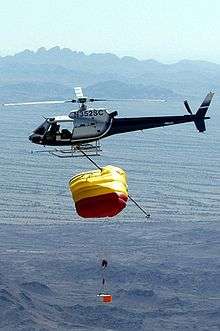Orion Lite
Orion Lite was an unofficial name used in the media for a lightweight crew capsule proposed by Bigelow Aerospace in collaboration with Lockheed Martin. It was to be based on the Orion spacecraft that Lockheed Martin was developing for NASA. It would be a lighter, less capable and cheaper version of the full Orion.
The intention of designing Orion Lite would be to provide a stripped down version of the Orion that will be available for missions to the International Space Station earlier than the more capable Orion, which is designed for longer duration missions to the Moon, Mars, Lagrange points, and Near Earth asteroids.[1]
Bigelow began working with Lockheed Martin in 2004. A few years later Bigelow signed a million-dollar contract to develop "an Orion mockup, an Orion Lite."[2]
Orion Lite's primary mission would be to transport crew to the International Space Station, or to private space stations such as the proposed Sundancer from Bigelow Aerospace. While Orion Lite would have the same exterior dimensions as the Orion, there would be no need for the deep space infrastructure present in the Orion configuration. As such, the Orion Lite will be able to support larger crews of around 7 people as the result of greater habitable interior volume and the reduced weight of equipment needed to support an exclusively low-Earth-orbit configuration.[3]
The Orion Lite is also not to be confused with the Orion Crew Return Vehicle, a scaled-down version of Orion proposed by the Obama administration. In an earlier budget proposal the Orion had been slated for cancellation altogether.[4]
The proposed collaboration between Bigelow and Lockheed Martin on the Orion Lite spacecraft has ended. Bigelow began work with Boeing on a similar capsule, the CST-100, which has no Orion heritage. The CST-100 was selected under NASA's Commercial Crew Development (CCDev) program to transport crew to the International Space Station.
Launch systems
The Orion Lite is proposed to be compatible with multiple launchers, including the existing Atlas V rocket. A human-rated version of the Atlas V would have to be developed in conjunction with the Orion Lite. Work on this has started, funded by stimulus funds granted under NASA's Commercial Crew Development (CCDev) program. Likewise, a human-rated version of the SpaceX Falcon 9 has also been suggested by Bigelow as a possible launch system.[3]
Recovery

In order to reduce the weight of Orion Lite, the more durable heat shield of the Orion would be replaced with a lighter weight heat shield designed to support the lower temperatures of Earth atmospheric re-entry from low Earth orbit. Additionally, the current proposal calls for a mid-air retrieval, wherein another aircraft captures the descending Orion Lite module. To date, such a retrieval method has not been employed for manned spacecraft, although it has been used with satellites.[5]
References
- ↑ Klamper, Amy (14 August 2009). "Company pitches 'lite' spaceship to NASA". MSNBC. Retrieved 7 September 2009.
- ↑ Bigelow still thinks big, The Space Review, 2010-11-01, accessed 2010-11-02. "[In October 2010] Bigelow revealed that he had been working with Lockheed Martin on a capsule concept in the 2004–2005 period. 'We engaged in a million-dollar contract a couple years after that with Lockheed, and they created for us an Orion mockup, an Orion Lite.'
- 1 2 Space Hotel Visionary Proposes Modified "Orion Lite" Spaceship for NASA: Bigelow Airspace's concept is for low Earth-orbit missions only, Popular Science, Jeremy Hsu, 14 August 2009
- ↑ Achenbach, Joel (2 February 2010). "Obama budget proposal scraps NASA's back-to-the-moon program". Washington Post. Retrieved 31 May 2011.
Instead of continuing to develop the Ares 1 and Orion, the administration wants to invest $6 billion over five years in a commercial space taxi to carry astronauts into low Earth orbit.
- ↑ "Discoverer 14 – NSSDC ID: 1960-010A". NASA.
| ||||||||||||||